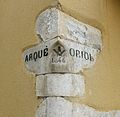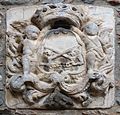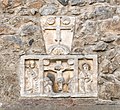Céret
![]()
The title of this article is ambiguous. For the river of the same name in France, tributary of the Cérou, see Céret (Cérou).
Céret (in Catalan Ceret) is a small town in southern France with 7821 inhabitants (as of 1 January 2018), located on the edge of the last, hilly foothills of the Pic du Canigou in the Pyrénées-Orientales department of the Occitanie region about 35 kilometres southwest of Perpignan and about 180 kilometres north of Barcelona. The town lies in the valley of the river Tech.
The name Céret is derived from Ceres, the Roman goddess of agriculture. The inhabitants call themselves les Cérétans. Also derived from Ceres is the national dance of the Catalans, the Sardane, which in earlier times was also called La Ceretane.
Céret is home to the medieval Devil's Bridge, which was the largest bridge in the world in the 14th century with an arch span of 45.45 metres.
Céret is famous throughout France for its art museum and its cherries. Thanks to its climatically advantageous location on the edge of the coastal plain of Roussillon, there is a particularly mild microclimate here in spring, so that the cherries ripen earlier around Céret than elsewhere in France. The farmers use this advantage for a clever PR strategy: the first basket is traditionally given to the French president. Because of the high wage costs, however, more and more farmers are uprooting their cherry trees and planting peach orchards instead. Part of the agricultural land is used for viticulture. The vineyards are located within the protected designations of origin Rivesaltes, Muscat de Rivesaltes and Côtes du Roussillon.

View of Céret

Geographical situation of Céret
Culture and sights
Cityscape
The townscape of the old town of Céret around the church of Saint Pierre and the meagre remains of the former town wall, between the Place de la République and the Place de la Liberté, is unique in the entire region: the boulevards between the tall town houses are shaded by enormous plane trees, and water runs along the curbs of today's central main shopping street and many side streets. As in ancient times, it is piped into the city from higher elevations via various canals and thus still serves a bit of street cleaning. More important, however, is its cooling effect in high summer. Catherine Millet described Céret in her scandalous book The Sexual Life of Catherine M. as "a city of elegance".
It was also the special atmosphere of the little town that made it a particular tourist attraction from the winter of 1909 onwards. At that time, three artists stopped off in Céret on their way to Banyuls to visit Aristide Maillol: the Catalan sculptor Manolo Martínez Hugué, the painter Frank Burty Haviland and the composer Déodat de Séverac. The icy, stormy Tramontane prevented them from continuing their journey, however, and so they had time to write letters to their acquaintances and colleagues telling them of the beauty of Céret. As a result, almost all the famous artists of French and Spanish Cubism visited the place and thus also contributed to making Collioure an artists' colony. Even today, Céret still boasts the title of "Mecca of Cubism", and you can feel the echo of this era in the Grand Café, the former meeting place for artists that still exists today.
· 
Water cools many side streets
· 
The Grand Café
· 
Sardane on the road
· 
Musicians at the weekly market
· 
Café Pablo Saturdays at the market
· 
National Day Parade
Museum of Modern Art
For tourists with an interest in culture, who come to relax on both sides of the Pyrenees, the town of Céret, situated in the centre of the Vallespir, is an attraction of the first order, without the place ever seeming overcrowded. Céret has an important museum of modern art (Musée d'Art moderne), whose collection comprises around 700 works by modern artists and is well worth a long journey: The collection includes more than 50 works by Pablo Picasso, more than a dozen drawings by Henri Matisse, a large-format painting by Marc Chagall, as well as various works by Joan Miró, Jean Cocteau, Raoul Dufy, Juan Gris, Aristide Maillol, Chaim Soutine, André Masson, Manolo Martínez Hugué, Auguste Herbin, Joan Brossa, Pinchus Kremegne, Jean-Louis Vila and others.
Of particular interest to most visitors are Chagall's gouache The Cow Under the Umbrella, Picasso's 28 red-brown-yellow clay bowls depicting bullfighting scenes, and a drawing also by Picasso, La Sardane à la Colombe.
Céret owes this collection to the painters Frank Burty Haviland and Pierre Brune, who had lived in the town since 1916, wanted to create a museum and called on his artistic friends in the region to "donate": The works of the older artists were actually donated to the museum by them. In more recent times, the permanent collection was constantly supplemented by the purchase of works by contemporary artists. From 1950 the steadily growing collection was on display in the former prison, since 1993 it has been housed in a new building.
Other places of interest
If you approach Céret from the Perpignan-Barcelona motorway via the D115 road, you will be surprised to glance to the left and right shortly after the current entrance to the town: Even crossing the river Tech over a modern road bridge, one discovers on the left an arched bridge of stone ashlars of exactly the same height, narrow and fragile in appearance, and on the left a narrow arched bridge of the railway, which is also no longer dewy-looking. The stone bridge dates from the early 14th century and is called Le Pont du Diable ('Devil's Bridge'), its single arch is 45 metres wide, and at its highest point it rises 22 metres above the river.
Only a few pieces of the medieval city wall remain, repeatedly restored in earlier times, but two former city gates: La Porte d'Espagne and La Porte de France, both dating from the 13th century. La Porte de France was the main gateway to the city, while La Porte d'Espagne, in Place Picasso, is now home to a museum of archaeology.
Another special feature is free public performances by a cobla on one of the boulevards from mid-July to mid-August. This traditional Catalan sardana dance orchestra attracts large numbers of locals to dance the round every Wednesday after 9pm, and a modest number of tourists to watch. The sardane is still a real folk dance in Céret for all ages, with seventy-year-old women, thirty-year-old men and ten-year-old children joining hands.
The war memorial on the Place de la Liberté was created by the famous sculptor Aristide Maillol (1861-1944).
· 
Street corner 1846
· 
War memorial by Aristide Maillol
· 
Portal of the Église Saint-Pierre
· 
Manolo Hugué: sculpture by Magali de Severac
· 
City coat of arms from 1723
· 
Marble relief (14th century) on the former Hôpital Saint-Pierre
· 
Portal de France

Le Pont du Diable , built 1321-1341
.JPG)
Musée d'art moderne de Céret
Twinning
Céret has been the twin town of Lüchow (Wendland) in Lower Saxony since 1983. Further partnerships exist with the municipalities of Almonte and Banyoles in Spain.
Questions and Answers
Q: Where is Céret located?
A: Céret is located in the Pyrénées-Orientales department in southern France.
Q: What was Céret's former role?
A: Céret was the capital of the historic Catalan comarque of Vallespir.
Q: Is Céret a subprefecture?
A: Yes, it is a subprefecture in the department and the capital of the Céret arrondissement.
Q: What country is Céret located in?
A: Céret is located in France.
Q: What region does Pyrénées-Orientales belong to?
A: Pyrénées-Orientales belongs to southern France.
Q: What type of administrative division is an arrondissement?
A: An arrondissement is a type of administrative division within a department or province in many countries, including France.
Search within the encyclopedia